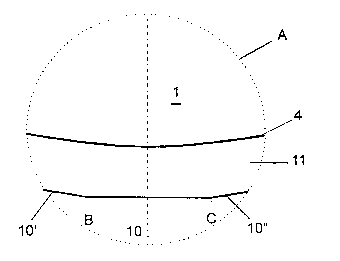Some of the information on this Web page has been provided by external sources. The Government of Canada is not responsible for the accuracy, reliability or currency of the information supplied by external sources. Users wishing to rely upon this information should consult directly with the source of the information. Content provided by external sources is not subject to official languages, privacy and accessibility requirements.
Any discrepancies in the text and image of the Claims and Abstract are due to differing posting times. Text of the Claims and Abstract are posted:
| (12) Patent: | (11) CA 2336912 |
|---|---|
| (54) English Title: | DEVICE FOR EMBOSSING GROOVED LINES IN CORRUGATED CARDBOARD |
| (54) French Title: | DISPOSITIF POUR LE GAUFRAGE DE LIGNES RAINUREES DANS DU CARTON ONDULE |
| Status: | Expired and beyond the Period of Reversal |
| (51) International Patent Classification (IPC): |
|
|---|---|
| (72) Inventors : |
|
| (73) Owners : |
|
| (71) Applicants : |
|
| (74) Agent: | SMART & BIGGAR LP |
| (74) Associate agent: | |
| (45) Issued: | 2003-07-29 |
| (86) PCT Filing Date: | 1999-10-13 |
| (87) Open to Public Inspection: | 2000-04-20 |
| Examination requested: | 2001-01-08 |
| Availability of licence: | N/A |
| Dedicated to the Public: | N/A |
| (25) Language of filing: | English |
| Patent Cooperation Treaty (PCT): | Yes |
|---|---|
| (86) PCT Filing Number: | PCT/EP1999/007712 |
| (87) International Publication Number: | EP1999007712 |
| (85) National Entry: | 2001-01-08 |
| (30) Application Priority Data: | ||||||
|---|---|---|---|---|---|---|
|
The invention relates to a
device for stamping groove lines
on corrugated board to better
fold and comply with the sizes of
boxes in production and processing
machines having a combined
grooving and transport body (1)
and a counter-body. The combined
grooving and transport body (1)
is fitted on its periphery with a
grooving ring (11) having straight
individual surfaces, said ring having
the shape of a regular polygon
with straight fiat pieces whose
number varies due to the different
peripheries.
L'invention concerne un dispositif pour imprimer des lignes formant des rainures dans du carton ondulé, cela pour permettre d'obtenir un meilleur pliage et le respect des dimensions lors de formation de boîtes, pour des machines de production et de traitement, lequel comporte un corps de rainurage et de transport (1) combiné et un contre-corps. Le corps de rainurage et de transport (1) combiné est pourvu, sur sa périphérie, d'une bague de rainurage (11) droite au niveau de ses surfaces individuelles, qui présente la forme d'un polygone régulier comportant un nombre de parties planes droites variant en raison de la différence de périphérie.
Note: Claims are shown in the official language in which they were submitted.
Note: Descriptions are shown in the official language in which they were submitted.

2024-08-01:As part of the Next Generation Patents (NGP) transition, the Canadian Patents Database (CPD) now contains a more detailed Event History, which replicates the Event Log of our new back-office solution.
Please note that "Inactive:" events refers to events no longer in use in our new back-office solution.
For a clearer understanding of the status of the application/patent presented on this page, the site Disclaimer , as well as the definitions for Patent , Event History , Maintenance Fee and Payment History should be consulted.
| Description | Date |
|---|---|
| Time Limit for Reversal Expired | 2018-10-15 |
| Change of Address or Method of Correspondence Request Received | 2018-03-28 |
| Letter Sent | 2017-10-13 |
| Inactive: IPC deactivated | 2017-09-16 |
| Inactive: IPC from PCS | 2017-01-07 |
| Inactive: IPC expired | 2017-01-01 |
| Maintenance Request Received | 2016-10-12 |
| Maintenance Request Received | 2015-09-28 |
| Maintenance Request Received | 2014-10-08 |
| Maintenance Request Received | 2013-10-11 |
| Maintenance Request Received | 2012-10-15 |
| Grant by Issuance | 2003-07-29 |
| Inactive: Cover page published | 2003-07-28 |
| Pre-grant | 2003-05-08 |
| Inactive: Final fee received | 2003-05-08 |
| Letter Sent | 2002-12-03 |
| Notice of Allowance is Issued | 2002-12-03 |
| Notice of Allowance is Issued | 2002-12-03 |
| Inactive: Approved for allowance (AFA) | 2002-11-19 |
| Inactive: Entity size changed | 2002-08-07 |
| Inactive: Cover page published | 2001-04-26 |
| Inactive: First IPC assigned | 2001-04-11 |
| Inactive: Acknowledgment of national entry - RFE | 2001-03-28 |
| Inactive: Inventor deleted | 2001-03-27 |
| Application Received - PCT | 2001-03-20 |
| All Requirements for Examination Determined Compliant | 2001-01-08 |
| Request for Examination Requirements Determined Compliant | 2001-01-08 |
| Application Published (Open to Public Inspection) | 2000-04-20 |
There is no abandonment history.
The last payment was received on 2002-07-23
Note : If the full payment has not been received on or before the date indicated, a further fee may be required which may be one of the following
Patent fees are adjusted on the 1st of January every year. The amounts above are the current amounts if received by December 31 of the current year.
Please refer to the CIPO
Patent Fees
web page to see all current fee amounts.
Note: Records showing the ownership history in alphabetical order.
| Current Owners on Record |
|---|
| HARALD GEHLE |
| Past Owners on Record |
|---|
| None |